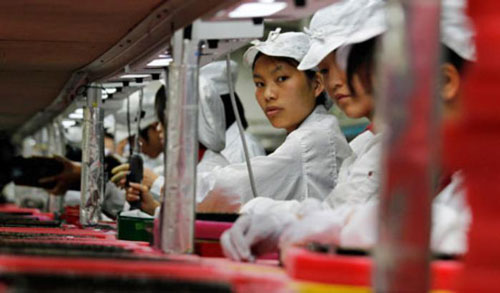
On 27 March, Hon Hai, which is also known as Foxconn, agreed to buy about 10% of Sharp, a struggling Japanese consumer-electronics company, for ¥66,9bn (US$808m). For a similar sum, its chairman, Terry Gou, and other investors are buying half of Sharp’s 93% stake in a factory in Sakai, in Japan, that makes large liquid-crystal display (LCD) panels.
As a symbol of the decline of Japan’s consumer-electronics industry and the rise of China’s (Hon Hai puts oodles of iPhones and iPads together at a huge complex in Shenzhen), the deal is hard to beat. Hon Hai has grown at an astonishing rate. This week it said it had hauled in more than NT$1 trillion ($33,8bn) in revenue in the last three months of 2011, almost a quarter more than a year before. Its net income rose by 83%, to NT$35bn.
It has begun 2012 at a stupefying pace: in January and February its revenue was 50% higher than in the same period last year. This owes much to Hon Hai’s contracts with Apple, which have yielded vast profits (as well as criticism about working conditions) for both.
In a recent report on Hon Hai, Kirk Yang of Barclays Capital estimates that this year the firm’s two business groups making things for Apple will contribute 39% of the overall company’s revenue, up from 34% in 2011.
In sad contrast, Sharp, like the rest of Japan’s electronics industry, has gone blunt. It expects that in the year to March its revenue will fall by almost one-sixth, to ¥2,6 trillion, and that it will lose ¥290bn. Most of its troubles can be explained by declining sales and prices of LCDs and LCD televisions, which account for something like 40% of its revenue. The Sakai factory, which opened in 2009, has been running at half its capacity. Alberto Moel of Sanford C Bernstein, an investment bank, says Gou’s purchase values it at around a third of what it cost to build.
If LCDs have become such a miserable business, why is Hon Hai so keen to get into it? On 28 March, indeed, it also promised to pump more equity into Chimei Innolux, a loss-making Taiwanese panel maker of which the Hon Hai group owns 11%. It has already bought LCD television factories in Mexico and Slovakia from another Japanese company, Sony, which is now its main LCD customer. Hon Hai may think that, with its ruthless attention to costs, it can succeed where the Japanese have failed. Or it may see in Sharp and its Sakai factory, from which Hon Hai will eventually take half the output, the promise of a technological step up.
Like other manufacturers in China, Hon Hai faces rising labour costs, though it is better placed than most. (Yang reckons that labour accounts for only 4,5% of the cost of goods sold.) A move up the value chain may help.
The deal may also be a hedge against Hon Hai’s most important customer: after all, there are lots of television and personal-computer brands that Hon Hai could supply with LCDs. Just as plausibly, however, Gou is making a bet on its continued success. He may reckon that Apple will, as has long been rumoured, soon start making televisions — and that he and Hon Hai will profit again. — (c) 2012 The Economist![]()
- Image: The Observer/Reuters (used with permission)




